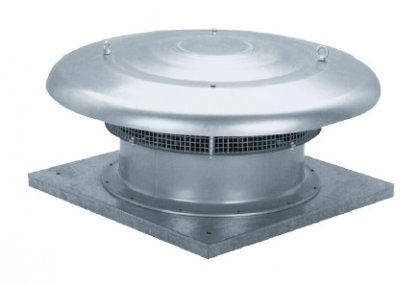In general, roof fans are designed so that even extreme rainfall does not cause the fan to leak. Since the fans are mounted on the roof structure, any leakage through the roof raises the suspicion of the fans being a "hole" in the roof.
In our extensive experience, we have seen cases that were initially categorized as fan leaks. However, this has never been confirmed. It is always necessary to look for the following causes.
- A leak in the roof sheathing at a remote point in the roof, with water flowing out through the opening where the fan is installed. The fan is waterproofed on the upper roof sheathing, the opening through the lower roof sheathing is not waterproofed and water leaks out at this point and runs down the lower roof sheathing.
- Condensate leaking from the ductwork connected to the roof fan (the solution should be sought in sufficient insulation of the ductwork and installation of a fan check damper).
- Closed control dampers in the ductwork, the fan operates at zero flow in the area of maximum pressure, and the negative pressure is such that water is drawn in and sprayed onto the fan mounting plate, into the air gap between the rotating radial impeller and the nozzle. Some of the water flows by gravity into the pipe connected to the fan, the greater part is discharged through the discharge side of the fan. Most of the water is discharged into the pipe when the fan is switched off. The solution is to open the dampers and operate the fan in the working part of the characteristic.
- Installing cable grommets in the fan mounting plate is a common source of leaks and leakage. The situation is even worse because this installation is not carried out by the installation company but by electrical subcontractors, whose interest in fans is often minimal.
- A defective seal under the screws of the fan base plate at the point of attachment to the roof plinth is a common cause of leakage.
- Deformed fan mounting plate is another cause of leakage. This occurs if the fan is dropped onto a pallet during transport. The weight of the motor and other structural parts will cause the base to buckle. Water does not run down the base but forms a deep pool. In the case of HCTT fans, for example, which have a split design, a certain depth of water, combined with the vacuum in the fan at low air speeds when the check damper is not yet open enough, can cause leakage through the joint. The base deformation mentioned above can also occur if the fan is pulled too hard against the bolts to the pallet during transport.
Caution!
A common misconception is that rain can be simulated with, for example, a garden horse, a garden hose, or that a fan can be tested for leaks by pouring water from a bottle into its discharge. But this is a mistake; rain simulation is carried out with special equipment in test rooms that cannot be replicated in these ways.


